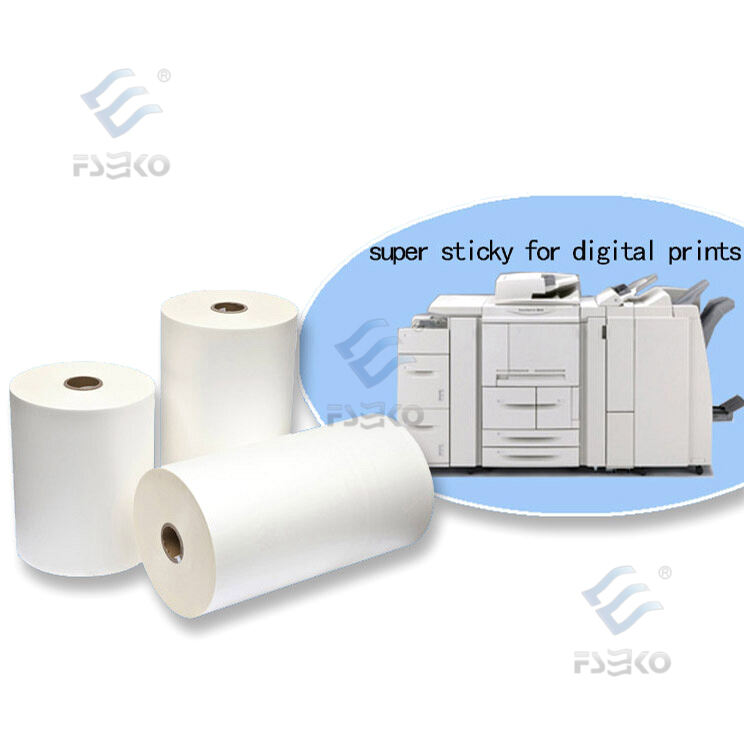Understanding Digital Thermal Lamination Glossy Film
What Is Thermal Lamination Film?
Thermal lamination film is a protective coating applied to printed materials using heat and pressure, enhancing their appearance and durability. Composed of a base material, typically BOPP, the film is coated with a heat-sensitive adhesive on one side, allowing it to bond securely to substrates. Varieties of thermal lamination film include glossy, matte, and silk finishes, each catering to different aesthetic and functional needs. Whether it's for a striking visual effect or increased resilience, these finishes offer diverse options for various applications, from glossy brochures to matte presentations.
The Evolution of Digital Lamination Technology
Digital lamination technology has seen remarkable advancements since its inception, transforming efficiency and quality in lamination processes. Initially, lamination was heavily reliant on manual methods, but today, automation and digital printing integration allow for precise application and faster production speeds. The introduction of Eco-friendly thermal films further underscores this evolution, addressing environmental concerns without compromising performance. These technological strides have enabled companies to meet growing demands for high-quality, sustainable lamination solutions while maintaining superior operational standards.
Why Glossy Finish Matters in Professional Applications
A glossy finish plays a vital role in enhancing the vibrancy of colors, making printed images and text noticeably stand out in professional settings. This reflective quality is particularly beneficial for marketing materials and presentations, capturing attention and delivering impact. Additionally, the use of glossy films in promotional displays and retail packaging can significantly boost consumer appeal. The allure of a glossy finish is often synonymous with higher perceived value, which fosters consumer trust and brand loyalty, ultimately supporting effective promotional strategies.
Key Factors to Consider When Choosing Thermal Lamination Film
Material Types: BOPP vs. PET vs. Specialty Films
When selecting thermal lamination films, it is crucial to consider the type of material as each offers distinct benefits. BOPP (Biaxially Oriented Polypropylene) is favored for its clarity, flexibility, and cost-effectiveness, making it suitable for a wide range of applications. On the other hand, PET (Polyethylene Terephthalate) is known for its superior heat resistance, often chosen for intricate designs and high-quality finishes. In recent years, specialty films such as biodegradable or custom-patterned options have become increasingly relevant, especially for brands aiming to enhance sustainability.
Thickness and Durability Requirements
The thickness of thermal lamination films, usually measured in microns or mils, is another critical factor. Standard thicknesses typically range from 1.5 to 10 mils, with thicker films providing more robust protection but potentially adding rigidity. When selecting the thickness, one must consider the intended use; for instance, materials exposed to high traffic will benefit from thicker films that offer additional durability, ensuring they withstand daily wear and tear effectively.
Heat Resistance and Environmental Impact
A key requirement for thermal lamination films is the ability to withstand the heat of the lamination process without distortion or losing adhesion. As environmental concerns grow, the availability of eco-friendly films that maintain high performance while offering a reduced ecological footprint is significant. Choosing materials with a lower carbon footprint not only fulfills corporate responsibility but can also enhance a brand’s sustainability profile, appealing to environmentally conscious consumers.
Compatibility with Digital Printing Systems
Ensuring that the chosen lamination film is compatible with your digital printing system is essential to avoid issues such as bubbling or peeling. Not all films work uniformly across different systems, making it imperative to verify their compatibility. Consulting manufacturers’ guidelines is advisable for achieving optimal adhesion and print quality, ultimately resulting in a professional and seamless finish that meets specific project requirements.
Benefits of Using High-Quality Thermal Lamination Film
Enhanced Print Longevity and UV Protection
High-quality thermal lamination films are essential for protecting printed materials from UV rays, which can lead to fading and color deterioration. This protective layer significantly enhances print longevity, safeguarding the vibrancy of documents. According to studies, laminated prints can last up to five times longer than those without lamination. For businesses, this translates into cost savings by reducing the need for frequent reprints and conserving resources.
Professional Finish for Commercial Applications
Thermal lamination provides printed materials with a polished and professional appearance that is crucial for client-facing documents. This superior finish enhances brand perception, potentially influencing consumers' decisions positively. Professionally laminated materials can make a lasting impression, increasing engagement with marketing endeavors and elevating the overall impact of commercial applications.
Scratch Resistance in High-Traffic Environments
In environments where materials are frequently handled, such as retail spaces, laminated surfaces offer scratch and scuff resistance, preserving the integrity of prints. Protective films play a crucial role in extending the usability of signs, menus, and promotional materials by maintaining their condition. This enhanced durability reduces replacement costs and ensures a consistent experience for customers interacting with these materials.
Applications of Hot Lamination Film in Various Industries
Packaging Industry: Luxury Product Protection
The packaging industry extensively uses hot lamination film to protect luxury products, maintaining the visual integrity of brands. In this sector, it's important to ensure that the packaging enhances the product's appeal and branding without suffering damage. Glossy lamination films are highly sought after for their ability to elevate a product's aesthetic appeal, making them more marketable and desirable to consumers. Such laminated packaging has become a norm, especially in luxury goods, as it significantly influences consumer perception, often swaying purchase decisions toward higher-end items.
Print Shops: Brochures and Marketing Materials
Print shops frequently apply thermal lamination to prolong the life of brochures, flyers, and other marketing materials. This process not only boosts durability but also imparts a sleek and polished look that greatly enhances client satisfaction. Laminated materials stand out for their professional appearance, which can be imperative when trying to make a strong impression through marketing endeavors. By offering thermal lamination, print shops can effectively upsell their services, thereby increasing profitability by offering premium-grade products that promise enhanced longevity and impact.
Electronics: Component Insulation Solutions
In the electronics industry, thermal lamination films serve as a critical component in insulating and protecting delicate parts. These films act as barriers against moisture and physical wear, which are common challenges in electronic manufacturing. By ensuring this additional layer of protection, lamination contributes to the extended lifespan and reliable performance of sensitive electronics. Advancements in film technology have only improved these insulation properties, making them increasingly essential and sought after in the electronics realm, especially as components continue to miniaturize and require more intricate protection solutions.
How Long Does BOPP Thermal Lamination Film Last?
Factors Affecting Film Longevity
The longevity of BOPP thermal lamination film is influenced by several environmental factors. Exposure to direct sunlight, fluctuations in humidity, and temperature variations can accelerate degradation, reducing the film's lifespan. Moreover, how users handle and maintain laminated materials plays a crucial role in determining their durability. Regular cleaning methods and frequency can affect how long the film remains effective. Opting for high-quality BOPP thermal lamination films can significantly extend their usability, offering better protection against environmental challenges over time.
Proper Maintenance Techniques
Proper maintenance techniques can substantially extend the lifespan of laminated surfaces. Regular cleaning with suitable materials can help preserve the appearance and performance of laminated items. It's essential to avoid harsh chemicals and abrasive materials, as they can damage the lamination layer. Additionally, storing laminated items away from direct sunlight and extreme temperatures further enhances their longevity by preventing premature wear and tear. By following these maintenance tips, users can ensure the lamination film maintains its protective qualities longer.
Signs It's Time to Replace Laminated Surfaces
Visible signs that it's time to replace laminated surfaces include discoloration, bubbling, or peeling edges, all of which signal the need for attention. Over time, the UV protection offered by the film diminishes, especially if the laminated item shows signs of fading. Regular inspections are advisable, particularly in high-use environments, to determine when replacement is necessary. Spotting these signs early can help maintain the quality and effectiveness of laminated surfaces, ensuring continued protection and appearance.


